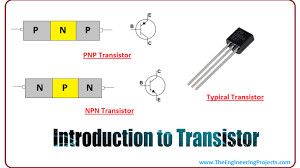
Our brain contains around 100 billion cells called neurons (the tiny switches that let you think and remember things). Computers contain billions of miniatures of "brain cells" as well, and they are called transistors. Commonly classified into BipolarJunction Transistors (BJT), and Field Effect Transistors (FET), these devices allow for the existence of radios, computers, calculators, etc. that you use today.
What are transistors?
Simply put, Transistors are semiconductor devices that are used for amplifying, controlling, and generating electrical signals. Transistors are the active components of integrated circuits, or “microchips,†which often contain billions of these minuscule devices etched into their shiny surfaces. Transistors have revolutionized electronics since they were first invented over half a century ago by John Bardeen, Walter Brattain, and William Shockley.
How are transistors made?
Transistors are made from silicon, a chemical element found in sand, which does not normally conduct electricity. (It doesn't allow electrons to flow through it easily). Silicon is a semiconductor, which means it's neither really a conductor (something like a metal that lets electricity flow) nor an insulator (something like plastic that stops electricity flowing).
How do transistors work?
A transistor can be considered as two P-N junctions placed back-to-back. One of these, namely the base-emitter junction is forward biased, whilst the other, the base-collector junction is reverse biased. It is found that when a current is made to flow in the base-emitter junction a larger current flows in the collector circuit even though the base-collector junction is reverse biased.
When current flows through the base-emitter junction, electrons leave the emitter and flow into the base. However, the doping in this region is kept low and there are comparatively few holes available for recombination. As a result, most of the electrons can flow right through the base region and onto the collector region, attracted by the positive potential.
Types of Transistors
Based on how they are used in a circuit there are mainly two types of transistors
Bipolar Junction Transistor (BJT)
The three terminals of BJT are base, emitter, and collector. A very small current flowing between base and emitter can control a larger flow of current between the collector and emitter terminal.
Furthermore, there are two types of BJT. These include;
P-N-P Transistor: It is a type of BJT where one n-type material is introduced or placed between two p-type materials. In such a configuration, the device will control the flow of current. PNP transistor consists of 2 crystal diodes which are connected in series. The right side and left side of the diodes are known as the collector-base diode and emitter-base diode, respectively.
N-P-N Transistor: In this transistor, we will find one p-type material that is present between two n-type materials. N-P-N transistor is used to amplify weak signals to strong signals. In an NPN transistor, the electrons move from the emitter to the collector region resulting in the formation of current in the transistor. This transistor is widely used in the circuit.
Field Effect Transistor (FET)
For FET, the three terminals are Gate, Source, and drain. The voltage at the gate terminal can control a current between source and drain. FET is a unipolar transistor in which N channel FET or P channel FET are used for conduction. The main applications of FETs are low noise amplifiers, buffer amplifiers, and analog switches.
Apart from these, there are many other types of transistors which include MOSFET, JFET, insulated-gate bipolar transistor, thin-film transistor, high electron mobility transistor, inverted -T field-effect transistor (ITFET), fast-reverse epitaxial diode field-effect transistor (FREDFET), Schottky transistor, tunnel field-effect transistor, organic field-effect transistor (OFET), diffusion transistor, etc.
Transistor applications:
Transistor as an amplifier
If we look at controlling a large voltage with a small voltage, we can say that we are performing an amplification.
1. Transistor as a switch
The transistor’s ability to act as a switch or perform a transfer of resistance makes it a very useful component in industrial applications.
Let’s look at how a transistor works as a switch.
The switch part of the transistor is between the Collector and the Emitter.
The switch is operated by changing the voltage between the Base and the Emitter.
If the input voltage is 0 volts, the switch is open, the resistance is infinite, and the output voltage is +10 volts.
If the input voltage is +10 volts, the switch is closed, the resistance is zero, and the output voltage is 0 volts.
2. Transistor radio
There are countless transistor applications.
One application that had a huge impact was the invention of the transistor radio.
Before the advent of transistors, radios were large bulky pieces of furniture filled with vacuum tubes providing the required audio amplification.
After the invention of the transistor, audio signals could now be performed by tiny transistors.
So, the transistor radio became portable and quite small.
Are you sourcing for transistors? At stockcheck, we have a large inventory of transistors. Start sourcing now.
 Share
Share